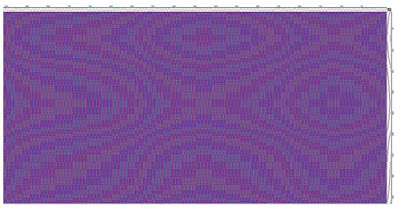Pictured above: a drawdown for Echo on 8 shafts. While the design appears to have four colors, there are just two colors in the warp and one in the weft. The design is based on a draft of mine that I call "Fun House" because the swirls and swoops remind me of images in a fun-house mirror.
How do you design something like this? Let's start at the very beginning -- which, with computer drafting, means a design line. Here's the one I started with.
Simple enough, right? Concave and convex curves and then curving lines. Based on this, I created an advancing point twill threading, substituting a point-twill block of four or five ends for each square on the design line. Here's what that looked like when finished.
If you look at the first square in the upper-right-hand corner of the design line, this corresponds to the first five ends of the point-twill in the threading (threaded on shafts 8, 7, 6, 5, and 6). The second square in the upper-right-hand corner of the design line becomes the next five ends on the threading (shafts 7, 6, 5, 4, and 5). So every square in the design line represents a block of point twill threading.
Next, I created a parallel threading, so that I could weave Echo. (A parallel threading on eight shafts usually means that every thread in the original single threading will now have a parallel thread -- usually 4 ends above it.) Here's what the advancing point twill threading above looks like.
You see the parallel lines? That's part of the technique known as Echo. And here's what the entire draft looks like when woven using the pattern of the original point-twill threading, with a twill tie-up of 1, 1, 1, 1, 2, 2.
There is a long threading pattern, which is hard to see, so here's a detail.
I like it -- and you may too, if you're still reading this! How did I create a parallel threading so that there are now two lines of point twill? This is easily done on Fiberworks by going to the drop-down menu under "Warp," clicking "Parallel Repeat," and then clicking "Extended Parallel," shafts shift by 4, and "Apply."
The original point-twill draft looks great on its own, tromp as writ. So why go to all this computer-drafting trouble?
If you're interested in learning more about Echo threading and color interaction, Marian Stubenitsky's book, Weaving with Echo and Iris, is an invaluable resource. Many of her designs use four parallel threadings in four different colors to achieve what she calls "iridescence." (Add the additional color of the weft and the results are truly beautiful.) Although my design uses just two colors in the warp and one in the weft, the result is a four-color fabric -- and it's just a one-shuttle weave!
Echo and extended parallel threadings are the subject of my 2 1/2-day workshop at Convergence 2018 in Reno. The official title is "One Warp, Many Structures: An Exploration of Extended Parallel Threadings." The workshop begins on July 10.
Here's another variation of this drawdown, just to pique your interest.
And here is the same draft, this time treadled as Jin (aka Turned Taqueté).If you've read this far, you need to sign up for the workshop ;o) General registration begins December 6. Thanks for reading.














